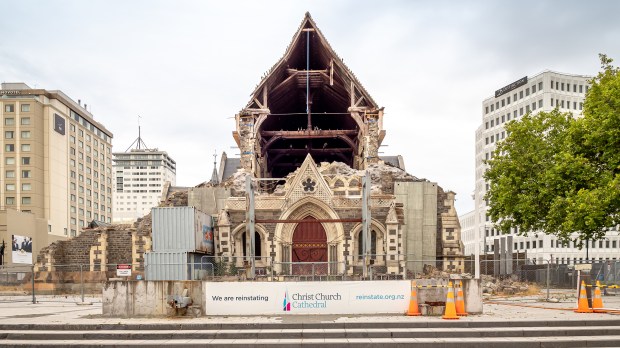Lenten Campaign 2025
This content is free of charge, as are all our articles.
Support us with a donation that is tax-deductible and enable us to continue to reach millions of readers.
A team of demolition workers at Christchurch, New Zealand’s Cathedral of the Blessed Sacrament have made an epic discovery. A collection of Catholic relics was excavated from the rubble. The relics were surprisingly preserved in coffee jars, buried beneath an inch of concrete.
Christchurch’s cathedral became pegged for demolition after earthquakes devastated the property in 2010 and 2011. According to The Guardian, the decade-long deconstruction process was a slow affair, as workers often found treasures which gave them pause. These finds have included altar stones, a decapitated Nativity scene, and a charity collection box with out-of-circulation coins.
Now, their biggest discovery has come in the form of long forgotten relics. Amassed by Bishop John Grimes during his 19th-century travels through Europe, they were once on display in the cathedral. In the 1970s, however, they were interred below the chapel, in sacred ground.
Coffee jars
The relics were placed within coffee jars, which protected them for the last 40 years. The larger of the two jars contained various bone fragments believed to have come from saints. The smaller jar contained small reliquaries containing scraps of fabric or flesh from historical Catholic figures.
Also discovered was an old soda bottle, in which there is a small rolled up paper. Workers have not yet attempted to unfurl the delicate paper, but its contents may help them identify the many relics.
Stuff reports that the task of identifying and cataloging these relics has fallen to Triona Doocey, archivist of the Archdiocese of Christchurch. She will accomplish this by sifting through records left by Bishop Grimes. She noted that few of the relics are properly labeled, and to make her job harder, a few of the relics were water damaged.
Although Doocey has her work cut out for her, she spoke excitedly about the opportunity to examine the relics. She said:
“We will tidy them up, clean them up and then repackage them safely so, no matter what gets thrown at them in the next cathedral, they will hopefully survive.” She added, “It gives us an opportunity to classify and catalog everything and capture that information for the future, so in 300 years time the archivist will know exactly what is there.”
The Archdiocese explained in a Facebook post that the relics that can be identified will be placed on display within the new cathedral for veneration. Those that cannot will be reburied under the new cathedral.


